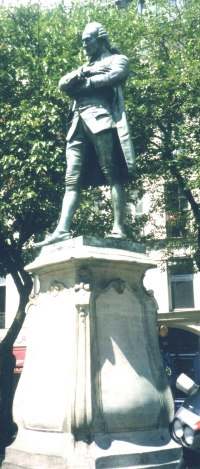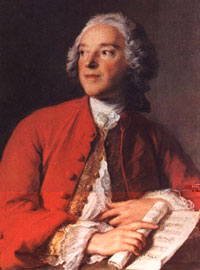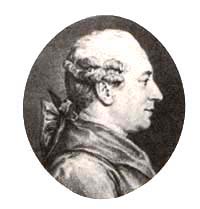|
Pierre-Augustin Caron was born in Paris, the son of a watchmaker. Initially, Pierre followed in his father's trade, and exhibited a talent not only with mechanical objects, but in the fields of music and writing. He taught the harp to the daughters of the French king Louis XV, which introduced him to the high society of Paris. Talented and handsome, Pierre became notoriously popular with women. By marrying in succession two wealthy widows and pursuing his own commercial activities, he acquired considerable financial means. He wrote successful theater pieces and engaged in other literary activities. His comedy The Barbarer of Seville was shown in 1775, and was a popular success with the broad public, if not all of the nobility. With his money and social connections, Pierre Caron was able to assume the name �de Beaumarchais' in 1756.
Despite his rather irregular background [or maybe because of it] the French foreign minister, Vergennes, turned to Beaumarchais to conduct a series of secret dealings in arranging for French support to the colonial rebels at the outset of the American Revolution. There is some speculation that Beaumarchais had eariler performed a secret mission in London for Louis XV and Mme Du Berry in 1774. However, the scheme set up in 1776 to support the American cause was quite elaborate.
To provide cover for his operations, Beaumarchais followed a pattern of deception already being undertaken by the French. Beaumarchais set up a fictitious firm
using a Spanish name: Roderigue Hortalez & Cie. The concept was to move arms and other war materials from French arsenals to North American agents, where the rebels' agents would, in return, load the Hortalez sponsored ships with rice, cotton, sugar and especially tobacco which could be sold in France (or other Continental ports) so as to cover the costs. Initially, the French government loaned a million livres and offered obsolete war mat�riel that had accumulated in the French depots due to considerable rearming and �modernization' since the Seven Years' War. [For example, the new Gribeauval artillery system was just beginning to be introduced, and musket models had been revised.] It was envisioned that Hortalez & Cie. would be self-supporting, and that Beaumarchais would bear the losses or receive any profits from the transactions. However, the scheme did not offer balanced rewards. While the Americans did benefit from the French shipments [There are some estimates that the significant portion of the arms and gunpowder used by American forces at Saratoga (October 1777) was the result of French aid.], most of the early Hortalez ships returned to Europe empty.
Hortalez & Cie had about 40 ships that were loaded at the ports of Le Havre, Nantes, Bordeaux, and Marseilles. The ships sailed to Martinique, San Domingo, or Port-au-Prince (now Haiti). There the goods were turned over to various agents for trans-shipment to the American insurgents. It is claimed that "by September, 1777, Beaumarchais had already shipped to America a total of five million gold livres' worth of cargo without the simplest acknowledgment in return. There were no bills of lading, no demands for receipts, and no demands for payments, inasmuch as it was known that the Americans had no money."
|
Suprisingly, this enterprise did not prevent Beaumarchais from completing his The Marriage of Figaro, a sequel to The Barber of Seville, in 1778. However, the anti nobility theme prevented the play from being performed until 1784.
Certainly, the Hortalez operation proved to be a financial disaster for Beaumarchais. In part, this was due to the most ignoble conduct of the Arthur Lee who reported in October 1777 to the US Congressional Committee on Foreign Affairs that the French foreign minister [Vergenne] had assured the US representatives in Paris [Franklin, Deane, and Lee], that the French aid should be considered grants, and that there was no return expected. This was certainly not the case, as attested to in many other reported transactions and confirmed by French representative who later reported to the US Congress. Lee's mischievousness seems to have been spawned by the fact that Lee had attempted to set up a separate arrangement with a competitor of Beaumarchais, and failed. Lee was joined by Thomas Pain and others in the US Congress who wanted to avoid any financial obligation to France. However, in January 1779, the French minister to the US issued an official denial of the position taken by Paine and Lee. On 15 Jan Beaumarchais was given a written apology from Congress and a �pledge' of payment, for as everyone knew, the US had no money to pay. In fact, the French would have to provide money to pay the US troops when mutinies occurred as late as 1781.
 Once the Franco-American alliance had been openly acknowledged in February 1778, and shipment of supplies from France enjoyed the protection of the French navy, the Hortalez operation became more profitable. Though by now, it was only a small portion of the total aid coming from France. In 1783, Hortalez & Cie was dissolved, with Beaumarchais technically eking out a small profit. Still, he believed that he was owed 3,600,000 livres from the US. In 1787, Arthur Lee was back in favor and appointed by Congress to examine the Hotalez accounts. Not surprisingly, Lee concluded that it was Beaumarchais who owed 1,800,000 livres. The issue remained embarrassingly alive, and Congress felt the need to have Alexander Hamilton examine the claim in 1795. Hamilton came up with the sum of 2,280,000 French francs owed by the US. But the US Congress still declined to pay the amount even as proposed by its own arbitrator.
Once the Franco-American alliance had been openly acknowledged in February 1778, and shipment of supplies from France enjoyed the protection of the French navy, the Hortalez operation became more profitable. Though by now, it was only a small portion of the total aid coming from France. In 1783, Hortalez & Cie was dissolved, with Beaumarchais technically eking out a small profit. Still, he believed that he was owed 3,600,000 livres from the US. In 1787, Arthur Lee was back in favor and appointed by Congress to examine the Hotalez accounts. Not surprisingly, Lee concluded that it was Beaumarchais who owed 1,800,000 livres. The issue remained embarrassingly alive, and Congress felt the need to have Alexander Hamilton examine the claim in 1795. Hamilton came up with the sum of 2,280,000 French francs owed by the US. But the US Congress still declined to pay the amount even as proposed by its own arbitrator.
Beaumarchais did not fare well in Revolutionary France. It was a society that did not support his life style, and by 1795, he was in financial ruin. Fleeing France he took refuge in Hamburg. One of his last personal appeals was for the Americans to provide his daughter a dowry. After many more appeals, and long after Beaumarchais' death, Congress acknowledged its debt. In 1835 Congress paid 800,000 French francs to Beaumarchais' heirs.
Beaumarchais's statue at a small park in the Marais area of Paris.
|


 Once the Franco-American alliance had been openly acknowledged in February 1778, and shipment of supplies from France enjoyed the protection of the French navy, the Hortalez operation became more profitable. Though by now, it was only a small portion of the total aid coming from France. In 1783, Hortalez & Cie was dissolved, with Beaumarchais technically eking out a small profit. Still, he believed that he was owed 3,600,000 livres from the US. In 1787, Arthur Lee was back in favor and appointed by Congress to examine the Hotalez accounts. Not surprisingly, Lee concluded that it was Beaumarchais who owed 1,800,000 livres. The issue remained embarrassingly alive, and Congress felt the need to have Alexander Hamilton examine the claim in 1795. Hamilton came up with the sum of 2,280,000 French francs owed by the US. But the US Congress still declined to pay the amount even as proposed by its own arbitrator.
Once the Franco-American alliance had been openly acknowledged in February 1778, and shipment of supplies from France enjoyed the protection of the French navy, the Hortalez operation became more profitable. Though by now, it was only a small portion of the total aid coming from France. In 1783, Hortalez & Cie was dissolved, with Beaumarchais technically eking out a small profit. Still, he believed that he was owed 3,600,000 livres from the US. In 1787, Arthur Lee was back in favor and appointed by Congress to examine the Hotalez accounts. Not surprisingly, Lee concluded that it was Beaumarchais who owed 1,800,000 livres. The issue remained embarrassingly alive, and Congress felt the need to have Alexander Hamilton examine the claim in 1795. Hamilton came up with the sum of 2,280,000 French francs owed by the US. But the US Congress still declined to pay the amount even as proposed by its own arbitrator.